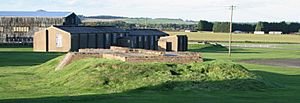National Museum of Flight facts for kids
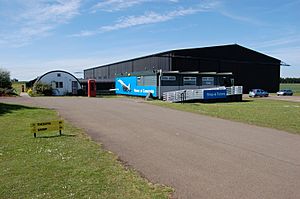
The entrance to the Concorde exhibition.
|
|
| Lua error in Module:Location_map at line 420: attempt to index field 'wikibase' (a nil value). | |
| Established | July 1975 |
|---|---|
| Location | East Fortune, Scotland, UK |
| Type | Aviation museum |
| Visitors | 74,696 (2019) |
| Official name | East Fortune, Airfield |
| Type | Military airfield |
| Designated | 29 November 1990 |
| Reference no. | SM4804 |
The National Museum of Flight is Scotland's main museum about planes and flying. It's located at East Fortune Airfield, a short distance south of the village of East Fortune in Scotland. This museum is part of the larger National Museums Scotland group.
The museum is set up in the original buildings from RAF East Fortune, which was an airfield used during World War II. Because these buildings are so well-preserved, the whole site is protected as a "scheduled monument." This means it's a very important historical place.
Contents
Museum History: How It Started
The museum's collection of aircraft began a long time ago, back in 1909. That's when the Royal Scottish Museum got its first aircraft: Percy Pilcher's Hawk glider. This was the very first aircraft ever collected by a museum in the United Kingdom!
Later, in the early 1920s, the museum added several aircraft engines. One special engine was a 1910 Wright engine, given to the museum by Orville Wright himself! In 1971, the museum received a Supermarine Spitfire XVI from the Ministry of Defence. This famous plane was too big to show in Edinburgh, so it was stored in a hangar at East Fortune.
More planes arrived the next year, including a Hawker Sea Hawk and a de Havilland Sea Vampire. With so many aircraft, the museum decided to open a special Museum of Flight at East Fortune. It first opened its doors to the public on July 7, 1975.
Over the years, the museum grew a lot. In 1981, it bought five more aircraft, including a de Havilland Dragon and a Percival Provost. Some of these planes even flew directly to the museum to become part of the collection! The de Havilland Comet arrived in 1981, and the huge Avro Vulcan flew in during 1984.
Another big addition happened in 2006 when British Airways donated many of its old aircraft. This included a BAC 1-11, a Vickers Viscount, and the front part of a Boeing 707. Visitors can actually walk through the 1-11 and 707, and even look into the cockpit of the Hawker Siddeley Trident!
In 2016, the museum completed a big project. They added heating and insulation to two of the hangars that were built way back in 1940. This helps protect the aircraft inside.
Amazing Aircraft Collections

The museum's collection has become one of the most important in the UK. It covers all kinds of flying, including military planes, passenger planes, and even planes used for fun. It's special because it's the only national museum in the UK that still collects items related to the history of commercial aviation (passenger flights).
This is why the museum put its Boeing 707 fuselage (the main body of the plane) on display in 2010. They also show a collection of items from BOAC (a famous old airline), like a 1960s flight attendant uniform.
Here are some of the cool aircraft you can see at the museum:
- Aero S-103 (a version of the MiG-15)
- Avro Vulcan B.2A (XM597), a large bomber that flew missions during the Falklands War
- BAE Systems Hawk T.1A (XX308) in Red Arrows colors
- Bristol Beaufighter TF.X (RD220)
- English Electric Lightning F.2A (XN776)
- General Aircraft Cygnet (G-AGBN), flown by Guy Gibson, the leader of the famous Dambusters Raid
- Hawker Siddeley Harrier (XV277), one of the oldest Harriers still around
- Messerschmitt Me 163 Komet (191659), a rocket-powered fighter that was the fastest plane of World War II
- Panavia Tornado F.3 (ZE934)
- Piper Comanche G-ATOY Myth Too, a plane flown around the world twice by Sheila Scott
- Supermarine Spitfire XVI (TE462)
Commercial Aircraft Collection
The museum also has a great collection of planes that carried passengers. Here are some of them:
| Year | Type | Airline/Livery | Notes | Photo |
|---|---|---|---|---|
| 1935 | Spartan Cruiser III | N/A | Only the front part of the plane. | 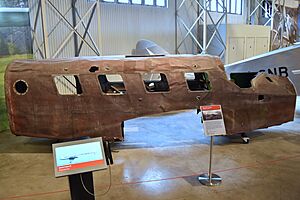 |
| 1942 | de Havilland Dragon | Silver | 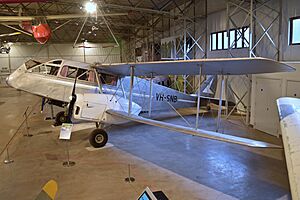 |
|
| 1953 | Beech 18 | Loganair | 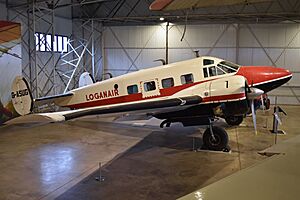 |
|
| 1954 | de Havilland Dove | Civil Aviation Authority Flying Unit |  |
|
| 1959 | Scottish Aviation Twin Pioneer | White, Red & Silver |  |
|
| 1960 | Boeing 707 | BOAC Golden Speedbird | Only the front part of the plane. It's a main part of "The Jet Age" exhibition. |  |
| 1962 | De Havilland Comet 4C | Dan-Air | On display outside. | 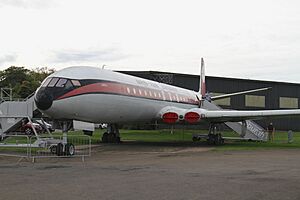 |
| 1964 | Hawker Siddeley Trident 1C | British Airways Negus | Only the cockpit section. |  |
| 1968 | BAC 1-11 | British Airways Landor | On display outside. | 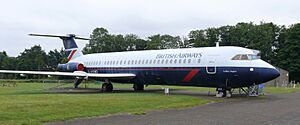 |
| 1969 | British Aerospace Jetstream 31 | British Aerospace | 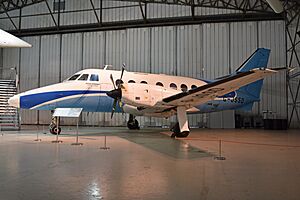 |
|
| 1975 | Aérospatiale-BAC Concorde | British Airways Chatham Dockyard | This is known as "Scotland's Concorde" and is the main part of "The Concorde Experience." |  |
| 1977 | Britten-Norman Islander | Scottish Ambulance Service |  |
The museum also has many other items, like:
- Lots of aircraft engines (including piston, turboprop, turbojet, and turbofan engines)
- Parts of aircraft (like wings from old planes)
- Avionics (electronic systems used in aircraft, including radars)
- Uniforms (military and airline)
- Medals and awards
- Weapons (like bombs, missiles, and cannons)
- Models of planes
- Photographs and documents about aviation history
What You Can See: Museum Displays
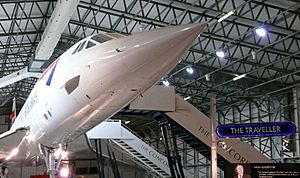
The museum has several hangars, each with different displays.
Hangar 1: Aircraft Care
This hangar is where the museum works on restoring and preserving aircraft. It's not always open to everyone, but you can sometimes take tours. Here you might see planes that are being fixed up or stored, like a Blackburn Buccaneer, a McDonnell Douglas F-4 Phantom II, and a Vickers Viscount.
Hangar 2: Military Planes
In this hangar, you'll find many military aircraft. These include the famous Supermarine Spitfire, the Bristol Fairchild Bolingbroke, the Armstrong Whitworth Meteor, the Panavia Tornado, and the SEPECAT Jaguar. You can also see the Messerschmitt Me 163 Komet, a rocket-powered fighter flown by the famous pilot Captain Eric Brown.
Other cool things here include an engine from the Messerschmitt Bf 110 flown to Scotland by Rudolf Hess, and various weapons used on planes, like machine guns and missiles.
Hangar 3: Passenger Planes
This hangar focuses on civil aviation, meaning planes used for passengers or other non-military purposes. Many of these aircraft have connections to Scotland. You can see the Scottish Aviation Twin Pioneer, which was built in Scotland, and a Britten-Norman Islander painted in the colors of the Scottish Air Ambulance Service.
Other planes here include a de Havilland Tiger Moth, a de Havilland Dragon, and a General Aircraft Cygnet. The Cygnet is special because it was flown by Guy Gibson, the leader of the famous Dambusters Raid in 1943.
Hangar 4: The Concorde Experience
This is one of the most exciting hangars! It's home to "The Concorde Experience" and "The Jet Age" exhibitions. You can walk through and around the amazing Aérospatiale-BAC Concorde (G-BOAA), listening to an audio guide that tells you about its history. There's also an exhibition about Concorde, showing its powerful Rolls-Royce/Snecma Olympus 593 engines and aircraft seats.
"The Jet Age" exhibition shows how jet engines developed over time and how they changed commercial flying. You can see different types of jet engines, from early ones to modern turbofans.
In 2018, a BAE Systems Hawk T.1A (XX308) was moved into Hangar 4. This plane is famous because it used to be part of the Red Arrows, the Royal Air Force's aerobatic display team. It was one of nine planes that flew with a Concorde over the Scottish Parliament building in 1999.
Other Exhibitions to Explore
The museum has even more to see in other buildings. There's a hands-on gallery called "Fantastic Flight" where you can learn about how planes fly. Another exhibition, "Fortunes of War," tells the story of the airfield during wartime. You can also visit "The Parachute Store," a restored building where parachutes were once packed. Other buildings display vehicles like a Green Goddess fire engine and an AEC Matador truck used by the RAF.
Events at the Museum
The museum used to host Scotland’s National Airshow every July. However, the airshow was put on hold indefinitely after 2021. But don't worry, the museum still holds other fun events throughout the year! These include the Wartime Experience in May and Wheels and Wings, a transport event in September.
See also
- List of aerospace museums


